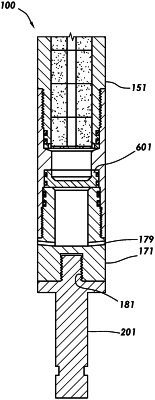| CPC E21B 43/1185 (2013.01) [E21B 34/063 (2013.01); E21B 43/119 (2013.01)] | 22 Claims |

|
17. A method comprising:
positioning a perforating torch in a casing or tubular desired to be perforated or severed, the perforating torch including:
a thermal igniter assembly, the thermal igniter assembly including a cartridge containment sub, a thermal igniter, and a thermal cartridge, the thermal cartridge including a cartridge housing and a nonexplosive combustible material positioned therein;
a compressed grain magazine, the compressed grain magazine coupled to the thermal igniter, the compressed grain magazine including a magazine housing and a compressed nonexplosive combustible material positioned therein; and
a perforating head assembly coupled to the compressed grain magazine, the perforating head assembly including a port, wherein the port is angled upward toward the top of the perforating torch;
activating the thermal igniter;
igniting the nonexplosive combustible material of the thermal cartridge;
igniting the compressed nonexplosive combustible material of the compressed grain magazine with exhaust gases of the nonexplosive combustible material of the thermal cartridge;
expelling exhaust gases of the compressed nonexplosive combustible material of the compressed grain magazine through the port of the perforating head assembly; and
forming an aperture in the casing or tubular using the exhaust gases expelled through the port.
|